

Auteurs: 7 Movie Directors Who Have Their Own Unique Style. In film criticism, auteur theory — the idea that a film reflects a director’s personal creative vision — has been a controversial subject since 1954, when French critic-turned-filmmaker François Truffaut first advocated that the director was a film’s primary author.

For Truffaut and other critics who wrote for Paris-based Cahiers du Cinéma, a film was most reflective of its director, displaying the style and themes that would be unmistakable throughout that person’s body of work. While auteur theory has continued to be highly influential in the film community, there’s an obvious problem: It minimizes the roles of the huge amount of people that work on a film, especially if the director is not the screenwriter. But does the director deserve author credit as the person who is responsible for directing all those different areas to shape his or her vision? That’s much harder to say, which is why the argument has shown no signs of slowing down after 60 years. 1. 2. 3. David O. 4. 5. 6. 7. The man who brought the magic back to film.
The Mise En Scène of Wes Anderson, a Video Essay Examining the Director's Quirky Style. There are very few filmmakers working today whose films are so heavily marked by their DNA, so much so that they're recognizable to cinephiles and casual moviegoers alike.

One of these filmmakers is Wes Anderson. Most people know a Wes Anderson movie when they see it; the distinguishing color palette, signature camera moves, the many, many overhead shots, but there is much, much more to be said about his visual themes. Nelson Carvajal peeks inside the director's imaginative world in this excellent video that showcases some of Anderson's best films, as well as voiceovers from interviews with the director in which he talks about his artistic sensibilities.
I know that it may not be super en vogue to admit, but Wes Anderson inspires the crap out of me (classy, I know), probably because Anderson himself seems to be inspired by early European cinema. Wes Anderson's Colour Palettes. The fictional worlds evoked in film by director Wes Anderson have such a precise colouration – the very particular pastel-hues that paint the skies, drench the buildings and dress the characters, render Anderson’s microcosms almost dream-like.
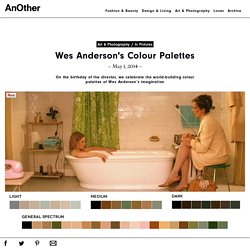
The hazy-hued lens through which we peer into the director’s unique world has a retro quality that casts his films in a nostalgia for a time that could have been. "The hazy-hued lens through which we peer into the director’s unique world has a retro quality that cast his films in a nostalgia for a time that could have been" Artist and Wes Anderson enthusiast Hamish Robertson says, “Anderson's colour palettes are integral to his cinematic ‘world-building’. His eye for art direction and fantastic attention to detail creates the appropriate space and tone for his characters to exist in – and for the viewer to lose themselves in.
Cinematography in Grand Budapest Hotel - Time in Pixels. It’s been a while since I saw any Wes Anderson movie and I knew that this was going to be good.
The number of things that I enjoyed in this movie exceeded all my expectations. The plot, the acting – it’s just a modest beginning. The cinematography aspect of this film is especially extraordinary and unique and in this post I would like to focus on this part the most. A Companion to Film Theory. Toby Miller is Professor in the Cinema Studies Department at New York University.
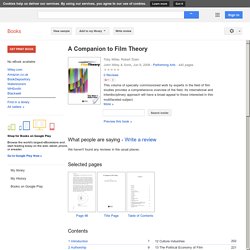
He is the author or editor of a wide range of work in cultural studies, including A Companion to Cultural Studies (Ed. Blackwell Publishing, 2001), Technologies of Truth (1998) and (with Alec McHoul) Popular Culture and Everyday Life (1998). He is also co-editor of the journal Social Text and (with Robert Stam) co-editor of Film and Theory: An Anthology (Blackwell Publishing, 2000).
Robert Stam is Professor in the Cinema Studies Department at New York University. His many books include Film Theory: An Introduction (Blackwell Publishing, 1999); Tropical Multiculturalism: A Comparative History of Race in Brazilian Cinema and Culture (1997); Unthinking Eurocentrism: Multiculturalism and the Media, with Ella Shohat (1994), which won the Katherine Singer Kovocs “Best Film Book Award”; and Subversive Pleasures: Bakhtin, Cultural Criticism, and Film (1992).
Understanding Film Theory - Christine Etherington-Wright, Ruth Doughty. 'This book addresses a very real gap in existing introductory texts that define, explore, and apply key theoretical concepts within the field of film studies.'Alison L.

McKee, Assistant Professor, Department of Television-Radio-Film-Theatre, San Jose State University, USA 'This is the book that film students have long been waiting for: a clear, well-written and accessible introduction to film theory. Lucid theoretical exposition and case study film analysis offer readers the most intelligible summary of theory that I have yet encountered.'Paul Sutton, Head of Media, Culture and Language, Roehampton University.
The Mark of a Director: Wes Anderson’s Idiosyncratic Style in The Grand Budapest Hotel : The Commentator. Date: April 7, 2014 1:16 pm Author: Whether Da Vinci’s “Mona Lisa,” or Shakespeare’s “Romeo and Juliet,” the author’s name remains intertwined with his work, in the title and in our minds.
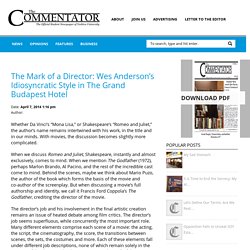
With movies, the discussion becomes slightly more complicated. When we discuss Romeo and Juliet, Shakespeare, instantly and almost exclusively, comes to mind. When we mention The Godfather (1972), perhaps Marlon Brando, Al Pacino, and the rest of the incredible cast come to mind. Behind the scenes, maybe we think about Mario Puzo, the author of the book which forms the basis of the movie and co-author of the screenplay. Auteur theory. Narrative Cinematography and the Significance of Style : An ana. Wes Anderson: Why His Movies Matter: Why His Movies Matter - Mark Browning. This first full-length consideration of this noted director's work, Wes Anderson: Why His Movies Matter is organized chronologically to encompass all of Anderson's films, from 1996's Bottle Rocket to Rushmore, The Royal Tenenbaums, and the 2009 release, The Fantastic Mr.
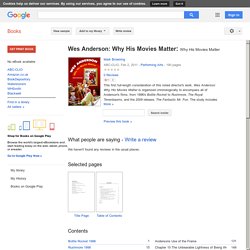
Fox. The study includes analysis of Anderson's work in commercials, his representation of race and class, his main stylistic influences, and his innovations in the use of frame. Beyond that, author Mark Browning considers whether Anderson's allusions create resonance or simply play a game with an audience keen to spot references.
Mise En Scène & The Visual Themes of Wes Anderson. Wes Anderson's DP Robert Yeoman on Bringing 'The Grand Bu. Cinematographer Robert Yeoman first made his mark with Gus Van Sant's "Drugstore Cowboy.

" Though he's worked with Noah Baumbach and on big-budget Hollywood fare such as "Bridesmaids," Yeoman is perhaps best known as Wes Anderson's cinematographer. Fox Searchlight The Grand Budapest Hotel Starting with "Bottle Rocket," Yeoman has worked on every single live-action film of Anderson's. Most recently, he shot "The Grand Budapest Hotel," for which he could receive his first Oscar nomination. Indiewire recently spoke to Yeoman by phone about working with Anderson and other auteurs, shooting "day for night" and the shift to digital.How much research and preparation did you do with Wes?
All of Wes' movies are pretty well researched and planned out. "Compared to most directors, there is way more extensive prep time on a Wes Anderson movie, for sure. " - Robert Yeoman. How Wes Anderson’s Cinematographer Shot 9 Scenes. There are few directors with a visual style as distinctive as Wes Anderson's, and to find out just what goes into his carefully composed shots, you'll want to talk to Robert Yeoman.
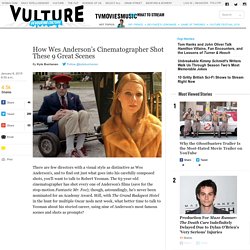
The 63-year-old cinematographer has shot every one of Anderson's films (save for the stop-motion Fantastic Mr. Fox); though, astoundingly, he's never been nominated for an Academy Award. Still, with The Grand Budapest Hotel in the hunt for multiple Oscar nods next week, what better time to talk to Yeoman about his storied career, using nine of Anderson's most famous scenes and shots as prompts? Bottle Rocket. Mise En Scène & The Visual Themes of Wes Anderson. The geometric perfection of Wes Anderson films. Wes Anderson // Centered. A Visual Analysis of Wes Anderson’s The Royal Tenenbaums. Although I had never seen a Wes Anderson film until very recently, I had always known him to be a quirky, indie, offbeat, and whimsical filmmaker. This assumption most likely grew from friends or family who have mentioned him in conversation, or critics whose reviews I have come across.
MOONRISE KINGDOM: Wes in Wonderland. DB here: “An auteur is not a brand,” argues Richard Brody. Not always, I’d suggest; but it can happen. And it’s not necessarily a bad thing. Wes Anderson has found a way to make films that project a unique sensibility while also fitting fairly smoothly into the modern American industry. He has his detractors (“I detest these films,” a friend tells me), but there’s no arguing with his distinctiveness. In any case, before summer’s end I want to look at the auteurish aspects of another Anderson film. Toy worlds When I’m making a movie, what I have in mind, first for the visuals, is how we can stage the scenes to bring them more to life in the most interesting way, and then how we can make a world for the story that the audience hasn’t quite been in before. Wes Anderson Filmmaking 101: Learn the Subtle Ways the Director Pulls You into His Films. Wes Anderson's Colour Palettes
The Cinematography of Robert Yeoman (Wes Anderson's DoP) A Beginner’s Guide to Wes Anderson Movies. Even if your interests don’t tend toward cinema’s indie side, you probably know Wes Anderson’s name; chalk it up to widespread critical praise, awards season recognition, or clever casting, but since making his 1996 debut with Bottle Rocket, he’s gained increasing visibility among mainstream audiences with each subsequent offering. He’s also been the recipient of in-depth scrutiny, both positive and negative, for his specialized, immediately recognizable, brand of filmmaking.
His latest movie, The Grand Budapest Hotel, has opened wide across the US, and reignited conversations about Anderson’s very particular approach to making movies. So, we at Screen Rant saw fit to present a guide to the elements that define his movies from the 90s to today. If you’re just now being introduced to his colorful sense of disaffected whimsy, we’ve got you covered on the basics of Wes Anderson’s filmography. Technical Precision.
The Cinematography of Wes Anderson's Go-To DP, Robert Yeoman. There's probably nothing more pleasing to my eye than the images created by cinematographer Robert Yeoman when he's working with Wes Anderson. The symmetry, the camera movements, the beautiful lighting -- it all serves to create a world that is, strangely, both unique and nostalgic. In this video essay by Nick Hansbauer, we get to take a look at the work of Robert Yeoman, from his first job (uncredited) on To Live and Die in L.A. in 1985 to his almost 20-year collaboration with Anderson. Even though Yeoman has worked on Hollywood films throughout his career, the fabric of his sensibilities is very independent. Working on films with low to low budgets gave him the opportunity to think on his feet -- to get creative and improvise in order to find solutions to the many obstacles inherent in cinematography.